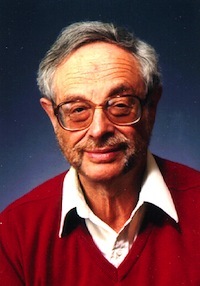Hans Schneider, leading mathematician, dies
As a research mathematician, Hans Schneider devoted his life to the revival of the classical field of linear algebra. While he was being considered for tenure, a famous Russian mathematician informed a member of the tenure committee that in Russia, “we expect every mathematician to know linear algebra but it is not a field for research.”
Rescued by other members of his department, Schneider realized the challenges ahead of him but committed himself nonetheless. He became instrumental in giving new stature to a branch of mathematics once regarded as old-fashioned and unworthy of serious investigation. His work in this once obscure field became a basis for the algorithms leading to the development of Google, the Internet’s most-used search engine.

Hans Schneider
Schneider, the James Joseph Sylvester professor emeritus of mathematics at the University of Wisconsin–Madison, died of esophageal cancer Tuesday, Oct. 28. He was 87.
“Hans Schneider is one of the most influential mathematicians of the 20th century in the field of linear algebra and matrix analysis,” said Daniel Hershkowitz, president of Bar-Ilan University in Israel and former Israeli minister of science and technology. “Through his editorial guidance, rigorous teaching of applied mathematics, and development of a cohesive community of researchers, Hans Schneider has made significant contributions to the breakthroughs in robotics and the theory of stability, a theory that in turn has played an important role in everything from the economy to ecology.”
Hans Schneider was born in Vienna, Austria, on Jan. 24, 1927, as the only child of two dentists, Hugo and (Isa)Bella (Saphir) Schneider. The family fled the Nazi occupation in March of 1938, traveling through Czechoslovakia and Poland before young Hans gained admission to a Dutch boarding school. Eventually, the family was reunited in Edinburgh, Scotland, in 1939 — three weeks before the outbreak of war.
Schneider attended George Watson’s Boys’ College and Edinburgh University, receiving an M.A. from the latter with First Class Honors. Initially, he obtained a position as scientific officer at the Royal Observatory, Edinburgh, but was fired within two years because he had broken an expensive brand new astronomical instrument.
Returning to Edinburgh University, he furthered his studies there under the idiosyncratic mathematical genius A.C. Aitken. Under pressure because of his growing family, he wrote a Ph.D. thesis within 18 months and was appointed to an assistant lectureship at Queen’s University, Belfast.
In 1959, Schneider arrived at UW–Madison, where he stayed for the rest of his career. In 1966, at age 39, Schneider was named department chair of mathematics, becoming one of the youngest to reach that position at a major American research university.
During his tenure, he held visiting positions at several universities including the Technion in Israel, the Technical University of Munich, and the University of Birmingham (UK).
As the longtime editor-in-chief of the prestigious journal Linear Algebra and Its Applications (LAA), he could redress the neglect of this field by established national mathematical societies. When he was named editor in 1972, the publication was obscure and struggling, with few submissions. By the time he retired from the position 40 years later, the journal was considered the leading publication in its field.
Schneider realized that groups in the mathematical culture — which tended to form around distinguished individuals — flourished for a time and then disappeared. Along with several colleagues, Schneider established the International Matrix Group in 1987, incorporated three years later as the International Linear Algebra Society (ILAS). In order to give the society permanence, he established a formal structure with annual elections. He served as its first president from 1990-1996.
In his later years, Schneider expressed contentment that his contributions had been taken up and developed by others, even when his original work might have been forgotten.
Currently, ILAS has about 400 members in more than 20 countries and publishes two journals. The 19th meeting of the society took place in South Korea in August 2014.
In 1993, the year he retired from UW–Madison, ILAS established the Hans Schneider Prize in his name. After that time, he would state, with care, that he had retired from teaching — implying that he was not retired as a mathematician. In his later years, Schneider expressed contentment that his contributions had been taken up and developed by others, even when his original work might have been forgotten.
Schneider was the author of nearly 160 influential research papers, covering many aspects of theoretical linear algebra. He submitted his first at the age of 24 and his last within a year of his death.
In 1948, Schneider married Miriam Wieck, a professional violinist; their marriage lasted over 66 years. He is survived by his wife; their three children, Barbara Schneider (Caswell), Peter Schneider, and Michael Schneider; and their six grandchildren, David and Dan Caswell, Hannah and Rebecca Schneider, and Carson Rose and Kurt Schneider.
—Portions excerpted from “Last Words of Hans Schneider”
Tags: mathematics, obituaries



